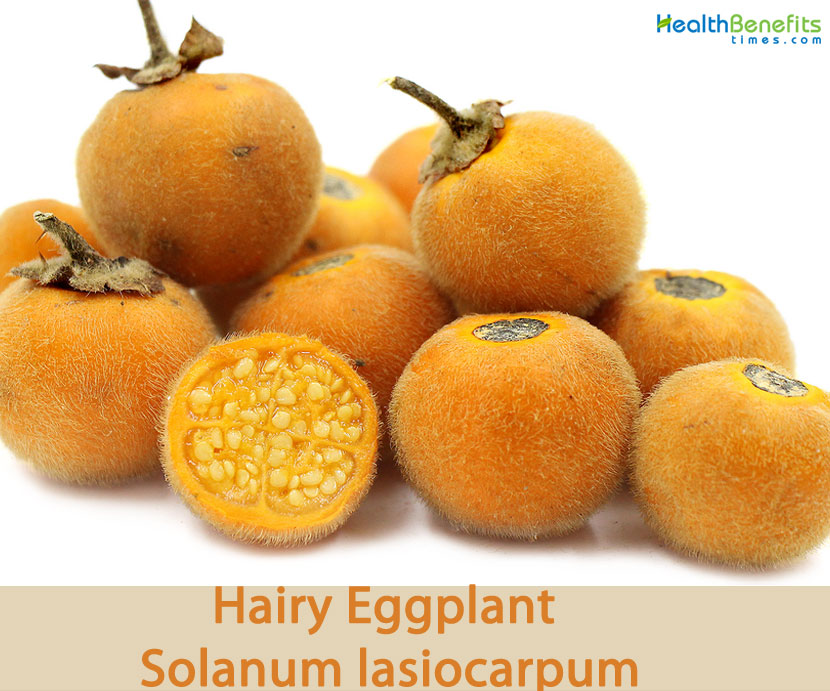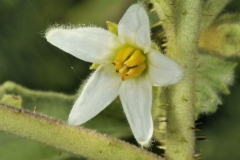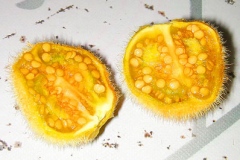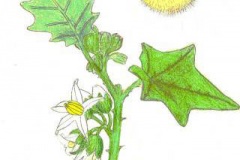| Hairy Eggplant Quick Facts | |
|---|---|
| Name: | Hairy Eggplant |
| Scientific Name: | Solanum lasiocarpum |
| Origin | South Asia – India, Sri Lanka; southeast Asia – Kampuchea Thailand, Vietnam Laos; Malesia – Malaysia, Indonesia, Philippines, New Guinea; southern China – Guangdong, Guangxi, South and southeast Yunnan; and Taiwan |
| Colors | Initially green when immature, but then ripens to a yellow or orange |
| Shapes | Small and round fruit, approximately 1-2 centimeters in diameter |
| Taste | Unique sweet and sour taste |
| Health benefits | Coughs, asthma, fever, vomiting, sore throat, gonorrhea, female sexual disorders, itches, cuts, wounds and syphilis |
| Name | Hairy Eggplant |
|---|---|
| Scientific Name | Solanum lasiocarpum |
| Native | South Asia – India, Sri Lanka; southeast Asia – Kampuchea Thailand, Vietnam Laos; Malesia – Malaysia, Indonesia, Philippines, New Guinea; southern China – Guangdong, Guangxi, South and southeast Yunnan; and Taiwan |
| Common Names | Hairy Egg Plant, Hairy-Fruited Eggplant, Hairy Nightshade, Indian Nightshade, Terong Asam, Thai Hairy-Fruited Eggplant, Wild brinjal |
| Name in Other Languages | Bengali: Ram begun Brunei : Tarong Pasai, Tokung Burmese: Kaw-ku-tha, Tarabi Chinese : Mao Ch’ieh, Mao Qie, mao Jia (毛茄), Yáng bù shí (羊不食) English: Indian nightshade, Wild brinjal, hairy-fruited eggplant, French : Aubergine De Siam Ŕ Fruit Hirsute India : Ram Begun Indonesia : Terong Perat, Cung Bulu, Latteoeng, Terong Asam Laotian : Khüa Khôn, Khüa Puux Malay: Dayak eggplant, Sarawak wild eggplant, Sour brinjal, Tarong pasai, Terong asam, Terung asam, Terong iban, Terung dayak, Pokok Terung Bulu Malayalam: Anamodumuttikka, Pechunda, Anachunda, Veluthavazhuthana Malaysia: Terong Berui, Terong Bulu, Terong Asam, Terong Dayak, Terung Iban Myanmar : Nbabawk, Sin-Hkayan, Sin-Kadi, Tarabi, Kaw-Ku-Tha Papua New Guinea : Su, Su-Lamas, Kova-Sakau Philippines : Talong Ayam, Tagutong, Balbalusangi, Basula, Tagatum, Kamadaka, Tarong-Tarong, Dabutung, Dagutung, Talong-Gubat, Talong-Talong, Tarambola, Tarambulo Portuguese: Tomateiro-bravo Sinhala: Mala batu Sri Lanka : Mala-Butu Sudanese: Karundang Tagalog: Tarong tarong Thailand : Mauek, Yang-Khui-Dee, Ma-Khuea-Puu, Ma-Puu Unidentified: Basula, Dabutung, Latteoeng, Tarong ayam Vietnamese : Cà Bung, Cà Du, Cà trái-lông Visayan: Tagatum |
| Plant Growth Habit | Sub-erect or spreading, lignescent perennial shrub |
| Growing Climates | Thickets, open forest, disturbed sites in rain forest or monsoon forest, near roads, humid places and wet places in ravines, valleys and forest openings |
| Plant Size | 1–1.5 m tall |
| Stem | Stems and branches stout, with flat, erect or slightly recurved prickles 1-8 mm |
| Leaf | Alternate, simple, large, green, 10–20 cm long and 8–18 cm wide pinnately veined, ovate to ovate elliptic, prickly with 4-6 short, broadly triangular lobes on each side, with smaller secondary lobes |
| Flowering season | Jun-Oct |
| Flower | Flowers are all bisexual and regular with 4-10 merous. Calyx is broadly campanulate, 6-9 mm wide, 6-9 mm long, the tube 2.5-4.5 mm, the lobes 3-5 mm long and 2.5-5 mm |
| Fruit Shape & Size | Small and round fruit, approximately 1-2 centimeters in diameter |
| Fruit Color | Initially green when immature, but then ripens to a yellow or orange and is covered in a fine layer of prickly hair |
| Seed | Seeds brown, ca. 2 mm in diam |
| Taste | Unique sweet and sour taste |
| Season | November-December |
Plant Description
A hairy eggplant is a sub-erect or spreading, lignescent perennial shrub that normally grows about 1–1.5 m tall. The plant is found growing in thickets, open forest, disturbed sites in rain forest or monsoon forest, near roads, humid places and wet places in ravines, valleys and forest openings. The stem is hairy, thorny and woody, with upright, spreading branches, sometimes with tinged light or dark purple.
Leaves
The leaf can be characterized as alternate, simple, large, green, 10–20 cm long and 8–18 cm wide pinnately veined, ovate to ovate elliptic, prickly with 4-6 short, broadly triangular lobes on each side, with smaller secondary lobes. The plant has 5-8 cm long petiole with very fine wool like hair. Besides, the upper leaves are usually smaller, narrower, less lobed and often sub-opposite than those at bottom.
Flower
Inflorescences usually short, 0.4-0.9 cm, extra-axillary, often very close to a leaf pair, unbranched, with 6-16 flowers, the distal ones female-sterile, and the axes stellate-pubescent. The flowers are all bisexual and regular with 4-10 merous. Calyx is broadly campanulate, 6-9 mm wide, 6-9 mm long, the tube 2.5-4.5 mm, the lobes 3-5 mm long and 2.5-5 mm, deltoid or broadly ovate-apiculate, abaxially densely sericeous or occasionally felty, the stellae with delicate, elongate midpoints, rays and stalks. Corolla 2.5-3.5 cm in diameter, 7-16 mm long, stellate, thin-textured, white, the tube 5-8 mm, the lobes 6-9 mm long and 3-6 mm wide, ovate-lanceolate or lanceolate, stellate-pubescent abaxially, glabrous adaxially. Stamens with filaments ca. 0.1-0.2 mm; anthers 6-8.5 mm long and 1.5-2.2 mm at base, linear-lanceolate, attenuate, connivent, yellow, the pores minute and directed distally. Ovary is pubescent, the hairs appearing simple but with underdeveloped rays at base; style 5-10 mm long and 0.25-0.6 mm wide, cylindrical, glabrous; stigma capitate. Flowering normally takes place in between June and October.
Fruit
Fertile flowers are followed by small and round fruit, approximately 1-2 centimeters in diameter. The tiny eggplant’s outer skin is initially green when immature, but then ripens to a yellow or orange and is covered in a fine layer of prickly hair. The inner pulp has many edible seeds and is also yellow or orange. Hairy eggplants are tangy and have a tropical, floral taste with a crunchy bite. Domesticated plants bear larger fruits and lack the prickly skin that is found in the wild plants. The color found in the center of fruit is light green, like that of Solanum quitoense. Numerous seeds are found that are 2.2-3.5 mm long and 1.75-2.5 mm wide, pale yellow, lenticular, slightly notched, broadly reniform-ovate in outline, the surfaces minutely pitted.
Traditional uses and benefits of Hairy Eggplant
- In Malaysia, a decoction of the roots is prescribed for violent pains all over the body and discomfort after meals.
- Root decoction is taken for syphilis.
- Roots are used externally in a bath for fever at night, and in a poultice for itches, cuts, wounds, and severe bruises.
- Seeds are used for treating toothache by burning them and inhaling the fumes.
- It is used as a remedy for coughs, asthma, fever, vomiting, sore throat, gonorrhea and female sexual disorders in Bangladesh and Indian traditional folk medicine.
- The Hairy eggplant is used to help stimulate the release of urine and to calm symptoms of splenic trouble in Suriname.
- In the Philippines, the leaves of the hairy eggplant as poultices are used to help reduce swelling and body pains.
- Leaf has been used as traditional medicine to treat against allergy, body ache and swelling, skin injuries, and headache.
- It is used by locals as Chinese herbal medicine for effective curing of cough, bruises, hernia, sore throat, and tooth decay, edema as well as having anesthetic effect.
- It has been used by the Tonchongya tribal community of Roangchaari Upazila of Bandarban district, Bangladesh to treat toothache and syphilis disease.
Culinary Uses
- The edible fruits are harvested from the wild or from cultivation.
- In India and Southeast Asia, the fruit is widely used as a sour-relish in curries and sauces such as nam prek in Thailand.
- Hairy eggplant is often used as a finishing condiment and paired with nam prik kapi, which is a Thai chili sauce made with shrimp paste and lime.
Other Facts
- It is used in traditional folk medicine in Asia.
- Fruit was reported to be used in black magic in Malaysia.
- Bunch of terong asam fruits and Dracaena in a net is placed on an expectant mother’s head and under the floor to prevent the approach of evil spirits.
- Seeds yield yellow colored oil, containing palmitic acid, stearic acid, oleic acid and linoleic acid.
References:
https://www.itis.gov/servlet/SingleRpt/SingleRpt?search_topic=TSN&search_value=821758#null
https://npgsweb.ars-grin.gov/gringlobal/taxon/taxonomydetail?id=416240
https://gd.eppo.int/taxon/SOLFE
https://en.wikipedia.org/wiki/Solanum_lasiocarpum
http://www.theplantlist.org/tpl1.1/record/tro-29600277











